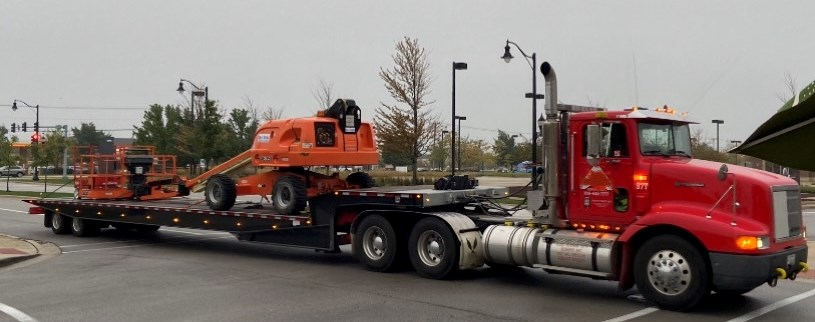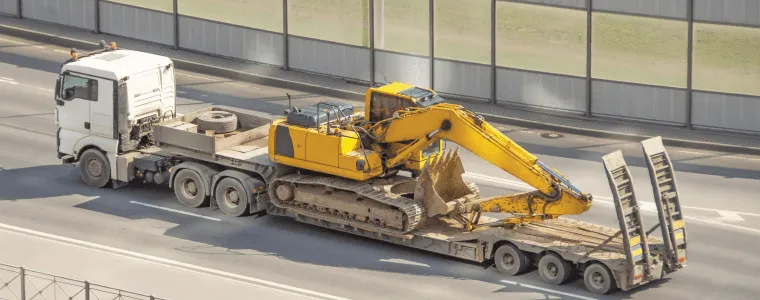
Transporting heavy machinery is a complex task that demands detailed planning and execution. Whether it’s moving construction equipment, agricultural machines, or industrial tools, the logistics behind heavy machinery transport require precision to ensure safety, compliance with regulations, and overall efficiency.
At BKK Transport, we understand that numerous factors influence how smoothly the process unfolds, from selecting the right Heavy machinery transport vehicles to managing potential risks. This blog will elaborate on the key elements you must consider for a successful machinery transport operation with us as your trusted partner.
The first step in planning the transport of heavy machinery is a thorough understanding of the equipment itself. Machinery shipping can vary widely in size, weight, and operational requirements. The dimensions of the machine—height, width, length, and weight—determine the type of vehicle needed and influence the route planning. For example, extremely tall or wide machines may require transport through special routes to avoid low bridges or narrow roads.
Another crucial aspect is whether the machinery can be transported in one piece or requires dismantling. Certain machines may have parts that extend beyond standard machinery hauling limitations, or may be too delicate to be moved as a whole. Dismantling them may be necessary to meet legal machine transport size restrictions or prevent damage during the journey. Additionally, the nature of the equipment—whether it has moving parts, hydraulic systems, or delicate electronics—also affects the handling and securing methods.
Selecting the correct transport vehicle is critical for both safety and cost efficiency. There are multiple options depending on the weight, dimensions, and type of machine transport. The most common transport vehicles for machinery shipping include flatbed trailers, lowboy trailers, and multi-axle trailers. Each offers different advantages depending on the machinery’s needs.
For extremely heavy machinery transport, a lowboy trailer may be the best option, as it allows for easier loading and unloading while ensuring compliance with height restrictions on public roads. For particularly long or irregularly shaped machines, extendable trailers or modular trailers can accommodate additional length. These trailers can be extended or configured to distribute weight more effectively and handle oversized loads.
Transporting heavy machinery requires meticulous route planning, as not all roads can accommodate oversized or overweight loads. Route planning should account for road conditions, bridge heights, overhead obstacles, and even traffic conditions. Some routes may be restricted based on the machinery’s size, necessitating alternative paths.
Securing the proper permits for oversized loads is another essential part of the process. Most jurisdictions impose strict regulations on oversized or overweight loads, and failing to secure the appropriate permits can result in fines, transport delays, or even legal repercussions. Some loads may also require pilot vehicles—escorts that guide the transport to ensure safety, especially when navigating tight corners or urban areas.
Additionally, time restrictions may apply to specific routes, requiring the transport to occur during off-peak hours to minimize traffic disruption. These regulations vary by region, making it essential to research local laws thoroughly.

Compliance with legal regulations is non-negotiable for heavy machinery transport. These laws ensure that oversized loads do not pose hazards to other road users and that the transport is carried out safely. Aside from the oversized and overweight load permits, additional legal considerations may include insurance, road taxes, and vehicle requirements.
Different regions may have unique requirements based on the machine’s weight, dimensions, and whether the machinery is considered hazardous. In some cases, local jurisdictions may require specialized equipment to handle the load or even mandate that the transport occur only during specific times of day.
For instance, in the U.S., the Department of Transportation (DOT) oversees the transport of oversized loads, and its guidelines dictate the maximum vehicle size, weight, and conditions under which pilot vehicles are required.
Safety is a significant concern in heavy machinery transport. Large, heavy equipment can pose a risk to workers, other road users, and the machinery itself. A failure to properly secure the load can result in shifting during transit, leading to accidents or equipment damage.
Start by ensuring that the machinery is adequately fastened to the transport vehicle. Use heavy-duty chains, straps, or tie-downs designed to hold the machinery’s weight securely. The load should be distributed evenly to avoid overloading one section of the vehicle. Uneven loads can cause tipping, increase wear on the transport vehicle, and make driving hazardous.
Beyond physical risks, consider potential weather-related issues. Rain, snow, or high winds can affect the safety of the transport, especially when traveling over long distances. It is vital to have a contingency plan in place in case of bad weather or mechanical failure.
Given the high value of heavy machinery, comprehensive insurance is essential. Transporting such equipment exposes it to potential damage, whether from road accidents, mechanical issues, or even weather conditions. Insurance should cover the machine from the moment it leaves the loading point until it arrives safely at its destination.
Standard insurance policies may not always cover specialized transport risks, so it is important to work with an insurance provider that understands the complexities of machinery transport. Coverage should include damage during loading, unloading, and transport, as well as liability coverage in case of accidents.
The process of loading and unloading heavy machinery requires specialized equipment and trained personnel. Depending on the machine’s size and weight, cranes, forklifts, or winches may be needed to move the equipment safely.
Before loading begins, ensure that the equipment is positioned correctly and that all securing devices are functional. Additionally, the loading/unloading site must be prepared to accommodate the transport vehicle, with sufficient space and stability for the machinery and any necessary lifting equipment.
Once the machinery arrives at its destination, conducting a thorough post-transport inspection is critical. Check for any signs of damage or wear that may have occurred during the journey. It’s also important to confirm that the machinery is in proper working condition before it’s put back into use.
Documenting the condition of the machinery before and after transport ensures accountability and provides necessary documentation in case an insurance claim is needed.
Heavy machinery transport is a multifaceted process that demands careful planning, strict adherence to safety protocols, and thorough knowledge of legal requirements.
Contact BKK Transport. We understand that every step, from grasping the machinery’s specifications to coordinating route planning, compliance, and risk management, plays a vital role in ensuring successful heavy-machine transport.
By focusing on these key factors and trusting us as your partner, you can minimize risks, avoid costly delays, and protect valuable equipment throughout the machinery shipping process.
Trust BKK Transport for Safe Shipping!
We specialize in heavy machinery transport, including construction equipment, agricultural machines, and industrial tools of various sizes and weights.
We follow strict safety protocols, using heavy-duty securing methods and choosing the right transport vehicles to ensure your machinery remains safe during machine transport.
Yes, we handle all aspects of machinery transport, including route planning, permit acquisition, and compliance with legal regulations.
Absolutely! We have the necessary expertise, equipment, and vehicles to manage machinery hauling for oversized or over-dimensional equipment.
We provide comprehensive insurance coverage to ensure your valuable equipment is protected throughout the entire machinery shipping process.